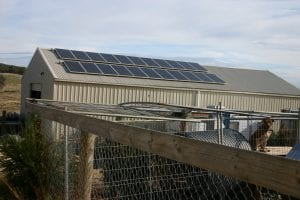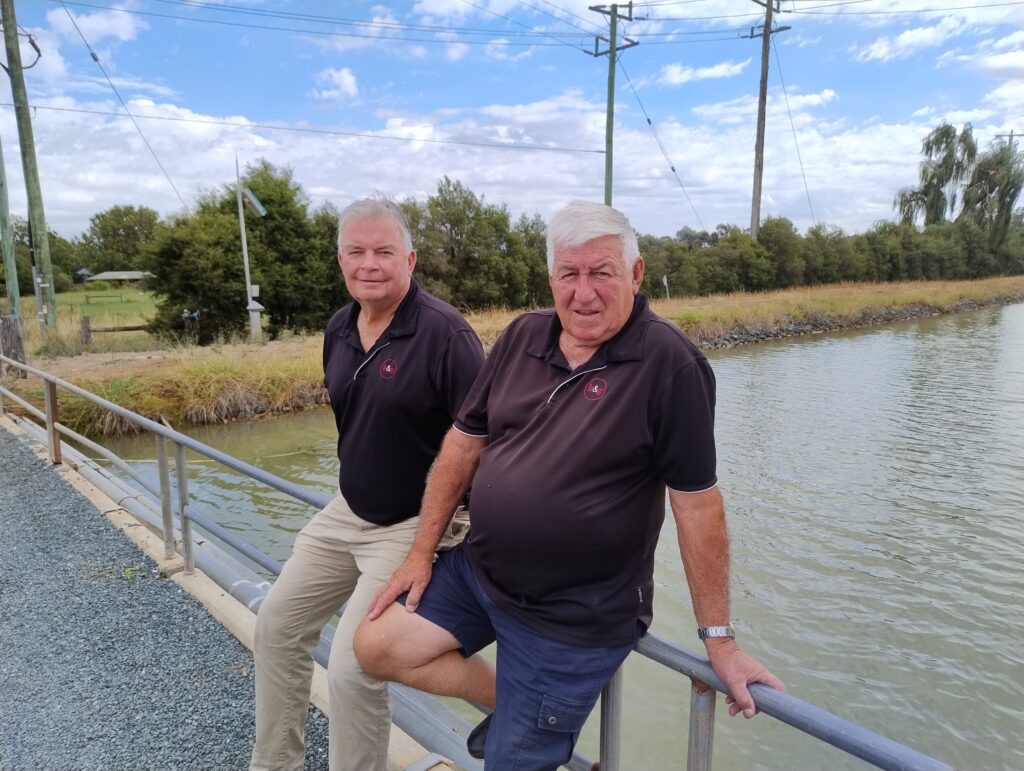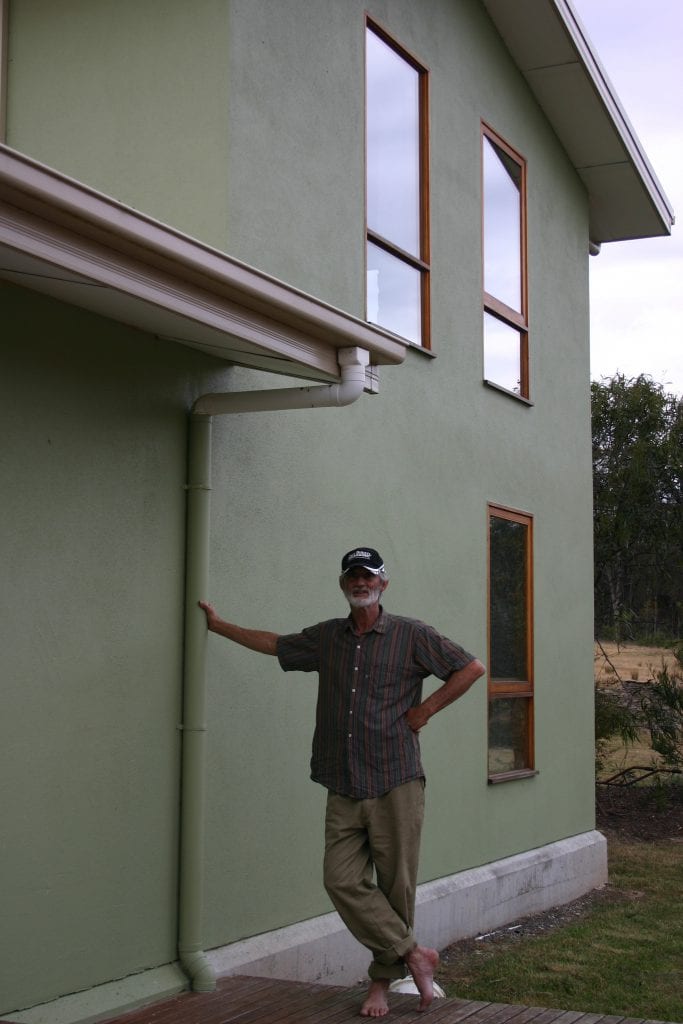Kieren Lewin lives a self-sufficient lifestyle on a 26ha property at Elphinstone in central Victoria.
On his property is a recycled house that is equipped with a stand alone 4.1 kilowatt solar energy electricity system, 150,000 litres of rainwater storage and an A and A worm farm septic waste treatment system. Kieren bought the land 3 years ago and then went looking for a house. He saw what he wanted in the Melbourne suburb, Bentleigh, where he found a 3-bedroom weatherboard with a metal sheet roof.
“Recycling an older house is cheaper than building new and then you can reconfigure it to what you want,” Kieren said.
He realised later another big advantage to recycling an existing house is it greatly reduces the time before the house is ready to live in.
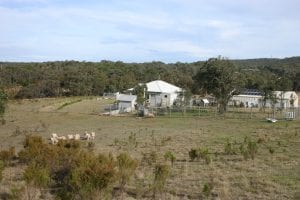
Kilmore House Removers relocated Kieren’s house on to his property and also sank the stumps and renewed the roof.
Once the house was at lock-up stage it was up to him and his “Uncle Max” Allen, a registered builder from Castlemaine, to complete.
This meant they needed insulation, reinforce some internal framework, replace floorboards, create doors and renew weatherboards. Before they sealed the interior and exterior walls Kieren organised for a plumber and electrician to visit.
Prior to the electrical wiring being installed a backhoe operator was hired to dig 1000 metres of trench for a telephone line and some water pipes. Once the electrician and plumber were virtually finished Kieren and his uncle began work.
“Uncle Max did most of the building work on the house,” Kieren said.
“He is one of those old school builders, he can do many different jobs.”
A main entry into the house is via an office cum mudroom where computers mingle with a wall mounted coat rack and space for boots.
From the office you pass a laundry and a separate toilet to get to the kitchen and living room. The kitchen has a built in pantry and other cupboards plus an LPG gas stove with a range hood.
Living self-sufficiently off the grid
The open plan living area has access to a northeast facing external deck. The bedrooms are located in the western and southern sections of the building while the kitchen and main bathroom face north.
The pantry and some kitchen cupboards and drawers have been recycled from the previous kitchen and the bathroom retains a vanity basin.
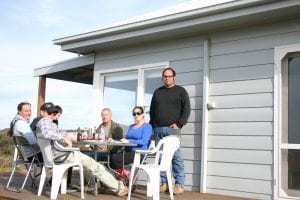
The recycled house has an above average energy rating
The recycled house has an above average 7.1 energy efficiency rating.
To obtain this rating Kieren installed insulation under the floor as well as in the walls and ceilings. Under the floor and in the walls there are R-3 batts made of Dacron (plastic fibre) and in the ceiling there is a double layer of R-3.5 fibreglass batts. Kieren has also laid reflective builders wrap as sarking across the roof’s rafters directly underneath the corrugated metal sheet roof.
Some people don’t realise they should only put sarking under corrugated metal roof sheets as this allows ventilation. Sarking laid directly under flat metal roof sheets can form condensation that will damage metal and timber. How to make a Straw Bale house
Kieren built a Colorbond shed on the property with a roof pitched to 22.5 degrees facing north that allows the solar panels mounted on it maximum exposure. The shed contains the solar power equipment and has 22 BP Solar 185 kilowatt solar panels mounted on it. The solar panels feed power into a Selectronic SP Pro Series model SPMC 241 4.5 kilowatt 24 volt inverter/charger.
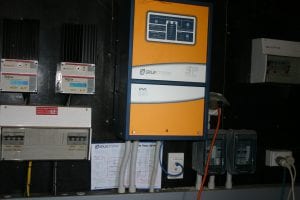
To avoid overcharging there are two Tri Star Solar Charge Controller units that regulate the amount of charge coming from the panels flowing into the battery bank.
Kieren stores the power in six 4-volt deep cycle lead acid Excel Energy model batteries that have so far needed minimal maintenance.
“I check the acid levels in the batteries basically every 4 or 5 weeks,” Kieren said.
There are 13 watt LED downlights throughout the house and 5-watt fluorescent lights for external lighting. At time of this interview Kieren has not experienced any power shortages in his three years on the property.
His house uses a variety of normal home appliances including a microwave, kettle, toaster, energy efficient fridge, washing machine, flat screen TV, telephone and computers.
How to keep a recycled house build going if delays arise
It took just two months to make the house suitable for inhabitation, or three months if you count the time it took to move it on to the property then restump it and replace the old roof.
Kieren believes the key to the short time it took to relocate and renew the house was due to a disciplined project management approach.
“If you want to keep (the project) within a certain time and budget you want to project manage it,” Kieren said.
One tip Kieren believed would be valuable advice for anyone thinking about recycling an old house was to anticipate delays and have the materials you need for the project on hand.
On hand before before any tradesmen were required Kieren had gathered building materials, pipes and other plumbing fittings.
This way he could judge the quality and manage the costs of the materials he needed as well as have materials available when required and so not delay the building process.
“If you have got all the materials (on site) then you can give the tradies a no stress option,” Kieren said.
As a former building project manager Kieren was aware the biggest time waster on site was altering a design mid build. Straw and Mud Sustains Lee
